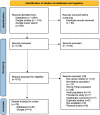Identification of Cancer Related Risk and Protective Factors for American Indian Youth: A Mixed Studies Review
- PMID: 35548066
- PMCID: PMC9081341
- DOI: 10.3389/fpubh.2022.828776
Identification of Cancer Related Risk and Protective Factors for American Indian Youth: A Mixed Studies Review
Abstract
Introduction: Many causes of cancer related morbidity and mortality can be traced back to childhood behaviors. The culmination of cancer related risk and protective factors impacting the health and wellbeing of American Indian youth is unknown. The aim of this Mixed Studies Review was to identify cancer related risk and protective factors among American Indian youth. Results will be shared with Tribal communities to inform surveillance efforts.
Methods: A Mixed Studies Review process was deemed most appropriate for the search process and data collection. Seven databases were included in the search along with 3 databases that were hand searched. Google Scholar and Google power searching were also conducted. Covidence was utilized for abstract and full-text review. Out of 1,512 articles, 75 articles were included for review and data from each article was sorted out into the levels of the social ecological model.
Results: After extracting significant cancer related risk and protective factors from the 75 relevant articles, cancer related themes were identified at the individual, relationship (family and non-family), community, institutional, and cultural levels of the social ecological model. It was observed that the risk and protective factor profile for substance use spanned all levels of the social ecological model, whereas physical health-diet indicators and sexual health indicators did not. Most articles (n = 58, 77%) focused on substance use-related risk and protective factors.
Discussion: The method that was used for this study can be utilized by other professionals researching risk and protective factors impacting the health and wellbeing of American Indian youth for a multitude of health outcomes. Tribal communities will be able to use the results from our literature review to inform the creation of a community specific data collection tool focused on cancer related risk and protective factors. Upon completion of the overarching research, results will be shared with the community and can be used to inform ongoing surveillance efforts, influence priorities for intervention and education work, and inform the management of resources. The continuation of community informed and driven research with Tribal communities is essential to the health and wellbeing of Tribal Nations as community grounded research is limited.
Keywords: American Indian; Native American; adolescent; protective factor; risk factor; youth.
Copyright © 2022 Nadeau, Wise, Farfan Cuela, Olson and Saravana.
Conflict of interest statement
The authors declare that the research was conducted in the absence of any commercial or financial relationships that could be construed as a potential conflict of interest.
Figures
References
-
- Centers for Disease Control and Prevention. YRBSS | Youth Risk Behavior Surveillance System | Data | Adolescent and School Health | CDC. (2019). Available online at: https://www.cdc.gov/healthyyouth/data/yrbs/index.htm
-
- Centers for Disease Control and Prevention . Participation Maps & History | YRBSS | Adolescent and School Health | CDC. (n.d.). Available online at: https://www.cdc.gov/healthyyouth/data/yrbs/participation.htm (accessed February 2, 2022).
-
- National Conference of State Legislatures . List of Federal and State Recognized Tribes. (2020). Available online at: https://www.ncsl.org/legislators-staff/legislators/quad-caucus/list-of-f... (accessed February 21, 2022).
-
- U.S. Cancer Statistics Working Group . U.S. Cancer Statistics Data Visualizations Tool, Based on 2020 Submission Data (1999-2018). U.S. Department of Health and Human Services, Centers for Disease Control and Prevention and National Cancer Institute; (2021). Available online at: www.cdc.gov/cancer/dataviz (accessed November 11, 2021).




